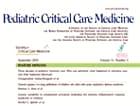Abstract and Introduction
Abstract
Objectives Continuous albuterol nebulization is generally administered at 2.5–20 mg/hr at most centers. We examined the effect of high-dose (75 or 150 mg/hr) albuterol on clinical variables in children with status asthmaticus.
Design Retrospective analysis of inpatient medical records and prospectively collected computerized PICU respiratory therapy database.
Setting Twenty-five-bed multidisciplinary PICU in a tertiary care children's hospital.
Patients Children admitted to the PICU between January 2006 and December 2007 with status asthmaticus receiving high-dose continuous albuterol nebulization. (Those with cerebral palsy, cardiac pathology, and ventilator dependence were excluded.)
Interventions Chart review for PICU length of stay, albuterol dose, duration of nebulization, occurrence of chest pain, vomiting, tremors, hypokalemia (serum potassium < 3.0 mEq/L), and cardiac arrhythmia. Maximal heart rate, lowest diastolic blood pressure, and mean arterial pressure were compared to the variables at initiation of therapy and at hospital discharge.
Measurements and Main Results Forty-two patients (22 boys and 20 girls) received high-dose continuous albuterol nebulization. Twenty-three received 75 mg/hr and 19 received 150 mg/hr (3.7 mg/kg/hr [interquartile range, 2.4–5.8 mg/kg/hr]) for a duration of 22.3 hours (interquartile range, 6.6–31.7 hr). Heart rate increased and diastolic blood pressure and mean arterial pressure were significantly lower during nebulization compared to initiation of therapy or at hospital discharge (p < 0.05). No patient required fluid resuscitation or inotropic support, and one had self-limited premature ventricular contractions. Hypokalemia occurred in five of 33 patients who had serum electrolytes measured but did not require supplementation. One patient required endotracheal intubation after initiation of nebulization, and seven patients (16.7%) received noninvasive ventilation. PICU length of stay was 2.3 ± 1.7 days; there were no deaths.
Conclusions High-dose continuous albuterol nebulization is associated with a low rate of subsequent mechanical ventilation and fairly short PICU length of stay without significant toxicity. Prospective studies comparing conventional and high-dose albuterol nebulization are needed to determine the optimum dose providing maximum efficacy with the least adverse effects.
Introduction
Asthma is a chronic illness with several major consequences, including school absence, decreased quality of life, emergency department (ED) visits, hospitalizations, and deaths. Although the quality of outpatient care for patients with asthma has steadily improved, severity of acute exacerbations and the mortality related to status asthmaticus remain unchanged.[1] Consequently, critical care physicians encounter patients with status asthmaticus who have failed initial urgent medical treatment and are admitted to the PICU for intensive therapy and monitoring. These patients frequently have impending or actual respiratory failure. According to national and international pediatric asthma guidelines, β-adrenergic receptor agonists and corticosteroids are the mainstay of therapy for status asthmaticus.[2,3] Although β-agonists are widely used during asthma exacerbations, there are many variations in terms of frequency, dosing, and route of administration.[4–6]
Albuterol is a β-agonist approved for nebulized therapy in children and is commonly used for treating asthma exacerbations in hospitals across the United States. Continuous nebulized albuterol delivered at 5–15 mg/hr has been shown to be superior to intermittent nebulization in children admitted to the ICU for status asthmaticus.[7] Even though continuous nebulization treatment is beneficial and widely used, the dose of albuterol remains variable in the absence of evidence directly comparing different doses. Most published studies describe fairly low doses for continuous albuterol nebulization (4–10 mg/hr). Among various expert opinions, the doses of albuterol recommended vary from 40 to 80 mg/hr, although dosing up to 150 mg/hr has been reported anecdotally.[8–10] The potential toxicity of higher albuterol doses has not been previously examined systematically.
At Loma Linda University Children's Hospital, continuous high-dose albuterol nebulization can be used to treat status asthmaticus in children. In children with significant respiratory distress, we initiate a dose of either 75 mg/hr (half diluted 5 mg/mL) albuterol solution delivered via a HEART nebulizer (High-output Extended Aerosol Respiratory Therapy, Westmed, Tucson, AZ, at 10 L/min oxygen flow) or undiluted albuterol at 150 mg/hr delivered in a similar manner based on the severity of the patients' presentation. Because the albuterol dose we use is considerably higher than that generally described in the published literature, the objective of this study is to examine the efficacy and safety of high-dose continuous albuterol in children admitted to our PICU with status asthmaticus.
Pediatr Crit Care Med. 2015;16(2):e41-e46. © 2015 Lippincott Williams & Wilkins









